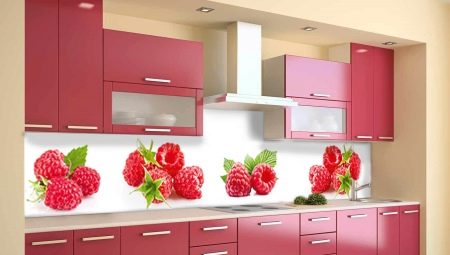Kitchen apron - the area located above the sink, hob and countertop. To design this site, plastic is often chosen. Unlike most other options, plastic panels are inexpensive, sold in a wide range of colors and are easily installed independently without the involvement of hired craftsmen.
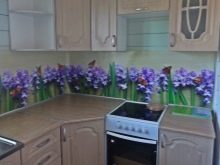
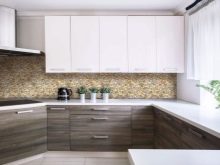
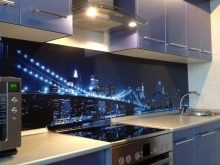
Features
A kitchen apron is constantly exposed to steam, moisture, grease splashes formed during cooking. That is why a number of requirements are imposed on him. He must:
- possess resistance to temperature influences;
- Do not deform with high humidity;
- easy to clean from various types of pollution;
- to be aesthetic, to combine and harmonize with kitchen items of furniture, decor and household appliances.
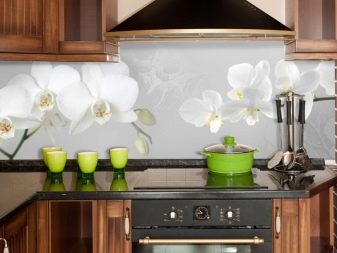
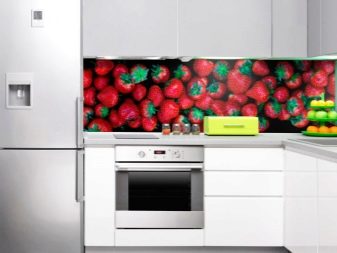
The vast majority of these requirements are apron for the kitchen made of plastic. There are several types of such products. They are classified according to the material from which they are made. Wall panels are made of ABC plastic, polycarbonate and PVC. All of them have their advantages and disadvantages, which are worth considering in more detail.
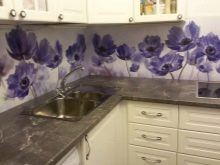


Advantages and disadvantages
When choosing plastic wall panels, you need to understand the features of each of their varieties. Plastic produced by various technologies has certain performance properties, various strengths and service life.
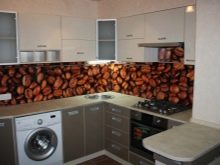
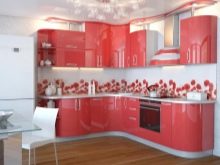

All this must be considered when choosing products.
PVC (polyvinyl chloride)
This kind of plastic has the most affordable cost. Often, such a decision is chosen by people with a limited budget, and he is also given preference for decorating an apron at the cottage or in rental housing. The material is available in the form of individual slats (lining) or wall panels of various sizes.
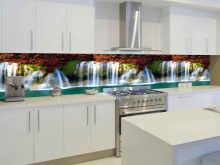
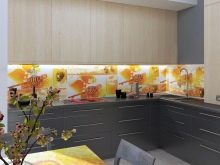
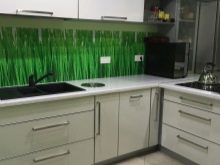
Products are made in a wide range of colors, can imitate the natural lining.
Another important advantage of PVC panels is their easy installation. Installation is made on liquid nails, a special adhesive or screws. The material is light weight, so one person can cope with its installation.
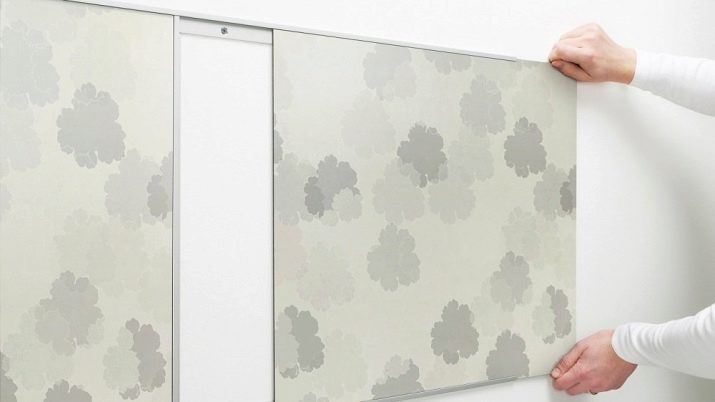
The cladding is fixed quickly, and the installation itself does not require special knowledge or experience.
The disadvantages of PVC panels include:
- poor resistance to mechanical damage - one awkward movement, and the panel will easily break and require replacement;
- susceptibility to abrasion - during operation, an apron will soon form scratches and scuffs, numerous consumer reviews confirm this fact;
- the appearance of yellowness and fading - all this occurs when exposed to ultraviolet sunlight and with frequent cleaning using detergents;
- fragility - products cannot last for a long time, no matter how neatly they are handled.

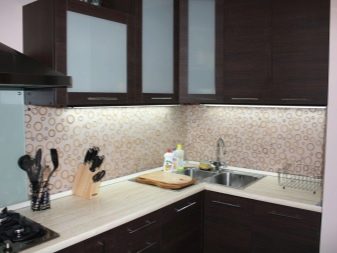
PVC panels have low resistance to high temperatures - when it rises above 80 degrees, the panels are deformed and can ignite. If poor-quality plastic is selected, during melting it will emit toxic substances hazardous to health. To reduce the risks of deformation of the cladding and its ignition, you should choose other materials, such as glass, ceramic tiles or mosaics, to decorate the area above the hob.
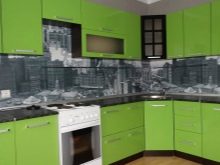
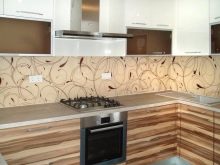
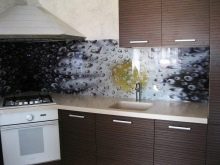
Polycarbonate (Acrylic Glass)
This is a material for the manufacture of which carbonic acid and phenol are used. There are two varieties of polycarbonate:
- cellular;
- monolithic.
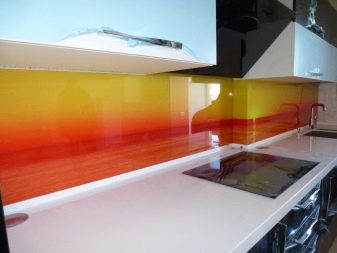
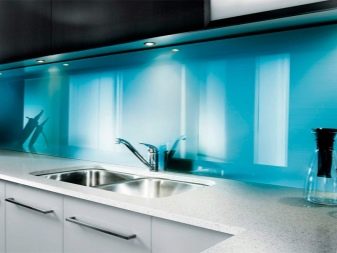
Outwardly, polycarbonate looks like silicate glass - it has a smooth and shiny surface. The material can be plain or decorated with photo printing. Advantages of the polycarbonate apron:
- excellent decorative qualities;
- resistance to power loads - the material is strong in bending and is able to "withstand" even strong shocks;
- resistance to direct sunlight - the surface will not fade or fade;
- fire resistance - being close to hot objects, acrylic glass will not light up, however it can melt;
- easy installation.
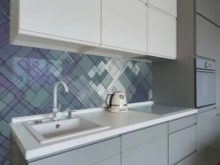
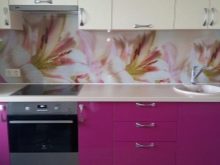
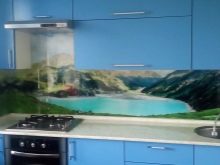
Polycarbonate cladding also has some disadvantages. For example, high cost compared to other types of plastic. If we compare acrylic glass with ordinary glass surfaces or mosaics, then the latter will cost more. Another disadvantage is the low resistance to abrasion, which is why when cleaning the apron you should not use tools with abrasives.
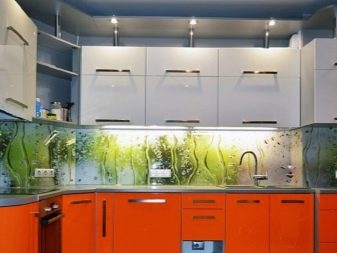
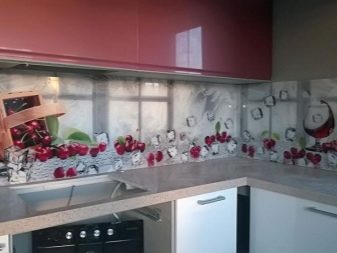
ABS plastic
This is a material made from acrylonitrite, butadiene and styrene. Products are lightweight sheets of various sizes. Such a cladding can be matte or glossy, have a metallized mirror layer.
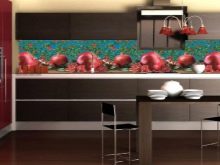
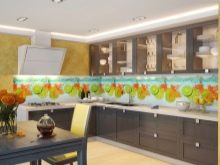

There are options with photo printing.
Advantages of ABS plastic:
- financial availability - this material is cheaper than glass, MDF or ceramic tile;
- shock resistance, bending strength;
- abrasion resistance;
- good flexibility, thanks to which the sheets are easily fixed even on uneven walls;
- easy transportation - if necessary, the product can be rolled up and it will take a minimum of space;
- easy do-it-yourself installation on liquid nails;
- easy cleaning - you can wash the panels with any washing and cleaning agents;
- resistance to temperatures (up to 80 degrees);
- environmental friendliness.
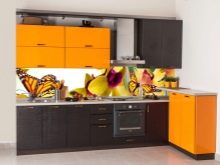


The disadvantages of ABS plastic include sunburn, “fear” of various solvents and acetone.
Subject Images
On plastic panels for an apron, photo printing is often applied. Some companies manufacture custom cladding - in this case, they are ready to satisfy all consumer requests regarding the applied picture.
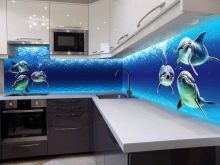
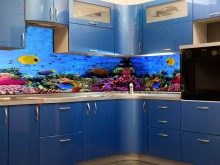
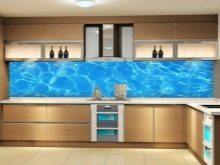
The choice of background subjects is often based on the personal preferences of the buyer.
One of the most popular topics in decorating an apron is floristry. The panels can show off orchids, daisies, tulips, poppies, roses and various floral arrangements. In such drawings, butterflies, birds, insects are often present, there are products depicting succulent grass. For any design of the working area, you can choose the color option - there are both bright drawings and images in more “calm” and gentle shades on sale.
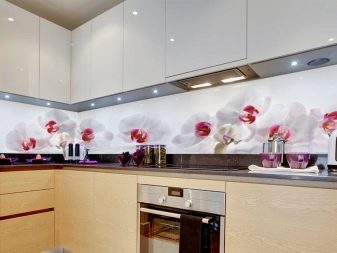
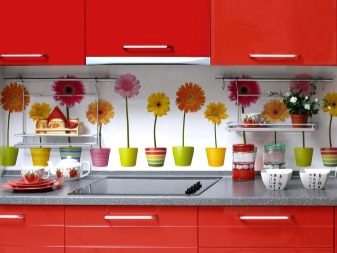
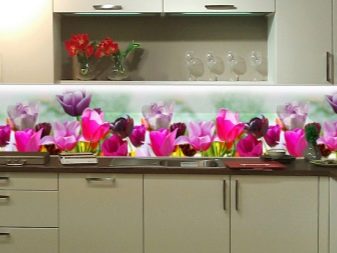

Another popular topic is fruits and berries. A close-up of citrus fruits with dew drops on the surface of the peel looks original and elegant. Often, various fruit and berry compositions are depicted on the lining - such pictures will correspond to any kitchen room.
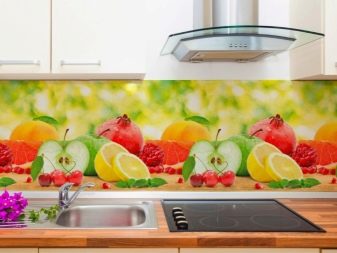

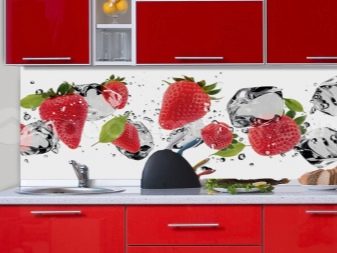
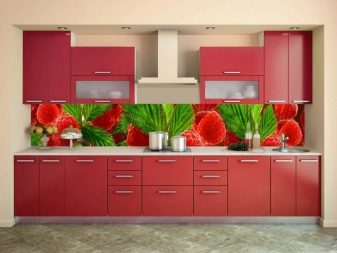
The subject is diverse: the apron often depicts nature, landscapes, still lifes, architectural structures, megacities, night cities. Photo printing on aprons is a great opportunity to make the kitchen brighter and more attractive.
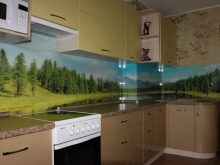
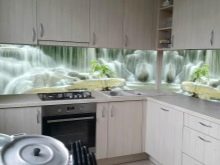
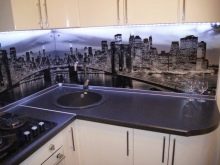
With the help of a properly selected image and color scheme, it is easy to visually expand a small room or to focus the attention of households and guests on an elegant working area.
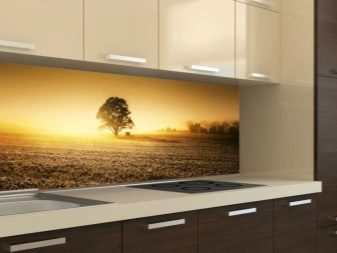

Color spectrum
A kitchen apron protects the surface of the walls from various types of pollution, and also performs a decorative function. To successfully fit it into the interior of the room, it is important to choose the right color palette of the panels. If it is not planned to focus attention on the working area, monophonic neutral colors are chosen. They can match the color of the kitchen itself, be transparent or lighter (darker) by 1-2 tones. These include white, gray, wet asphalt, beige and cream color.
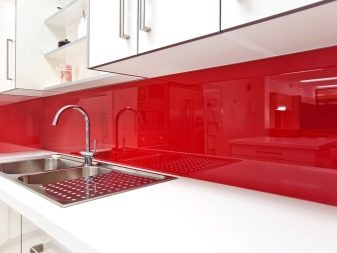
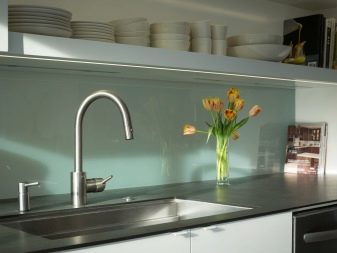
Aprons can have a bright color scheme. Plastic panels are:
- green
- orange
- red
- blue
- purple
- pink;
- blue
- maroon;
- light green.
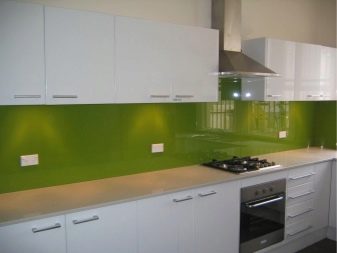
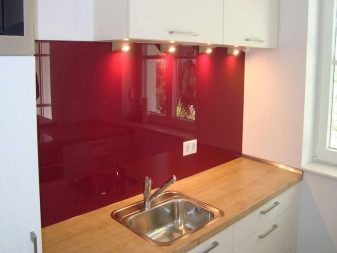

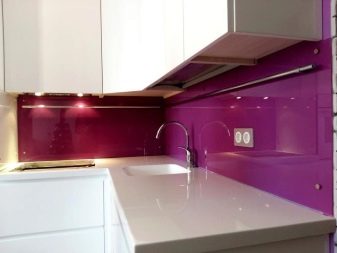
The bright color of the apron can be combined with the handles of the headset of the same color, decorative inserts on furniture, shelves, dishes and various items of decor and interior design. Sometimes people prefer aprons of dark tones. It can be black, dark purple and deep blue. Such an apron will look stylish and elegant, but it is not suitable for every kitchen - if the headset is made mainly in dark colors, this area must be made light.
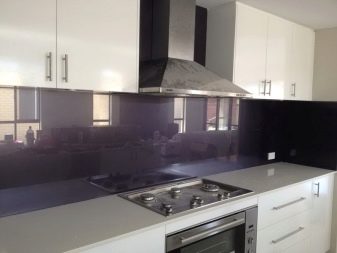
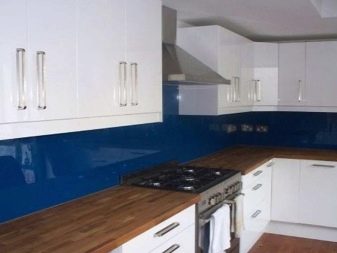
Design options
Thanks to plastic wall panels, you can embody a design idea of any complexity. These finishing products can have interesting textured solutions, a surface with a relief, be monophonic or with a printed image using photo printing.
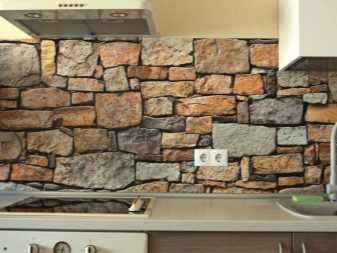
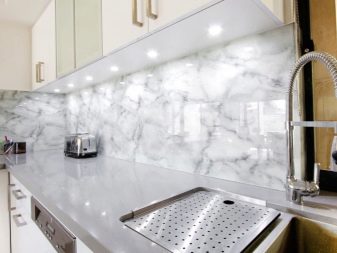
Recently, 3D wall-mounted plastic panels are gaining more and more popularity. Due to interesting images, you can make any kitchen more original, interesting and exclusive. The scenes of such photographs can be mentally transferred to forests, luxurious blooming gardens, to the sea, to the islands. Visually smooth and shiny panels resemble glass skins. However, the latter cannot be drilled to install railing or shelves. In plastic, it’s easy to make holes.
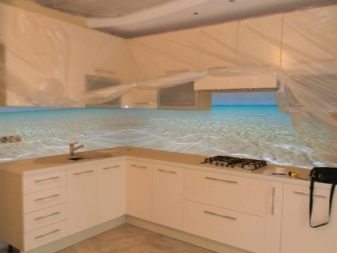
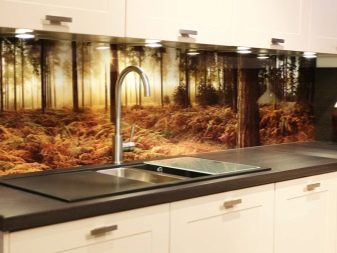
Plastic aprons imitating a natural facing do not reduce their popularity. Such panels can save not only money, but also the time taken to install them. For example, laying a brick or tile will require a lot of effort during installation, sometimes you even have to hire specialists to fix these materials.
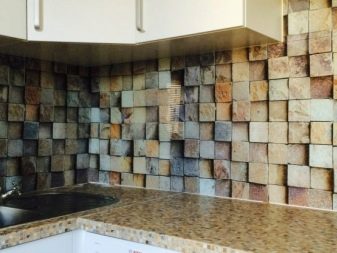
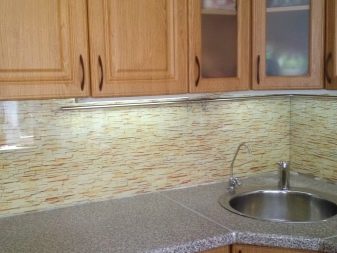
Plastic panels for tiles or for bricks are easy to install with your own hands in a short time.
Decorative wall cladding can visually imitate ceramic boar tiles, artificial or natural stones, wood. The options are “wood-like” or “mosaic”. A large selection of design solutions allows you to choose products to both classic styles and modern.
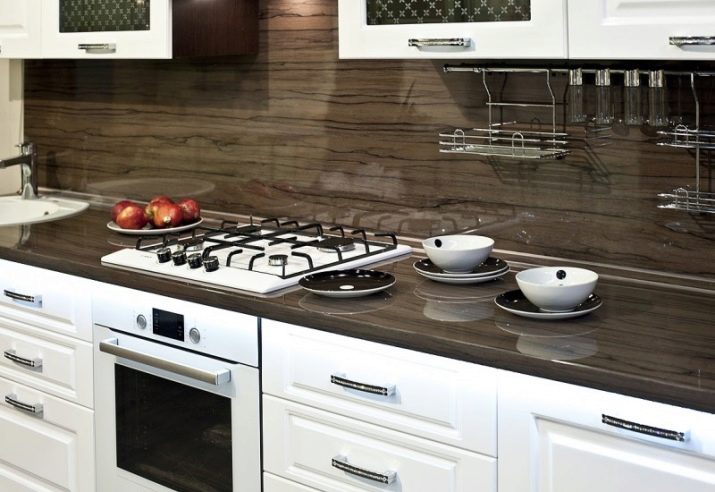
Manufacturers Overview
The Russian market primarily sells domestic-made plastic aprons. They differ in favorable cost and good quality. The leading companies in production and sales are the following companies.
- Stolplit Is a company founded in 1999. Its main activity is the production of furniture for the home. One of the largest companies in Russia, producing wall panels on European equipment. Stolplit engineers are constantly looking for new solutions and offer consumers innovative ideas for designing the kitchen working area.
- Versailles - A domestic manufacturer of plastic wall panels for lining the kitchen apron. Engaged in the manufacture of products based on MDF boards. It offers an extensive assortment of panels with colors, cities, nature, abstraction, geometric patterns.
- "Palette". Russian manufacturer engaged in the manufacture of high-quality plastic panels with a glossy or matte surface. Most of the ready-made solutions are framed by photo printing.
- "Century" - The company is engaged in the manufacture of plastic panels for the design of the apron area. A Russian company offering a wide range of products for all types of kitchens in a wide price segment.
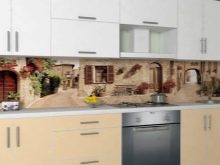
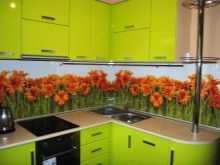
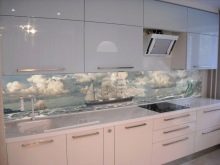
Most Russian manufacturers use foreign equipment for applying photographic printing to wall panels. As a result, they manage to create a bright cladding with unlimited design possibilities.
How to choose?
When looking for a plastic apron for the kitchen, it is important to make the right choice. To do this, you need to know a few nuances. It is best to refuse to buy PVC products - they are of poor quality and quickly deteriorate. More reliable and durable panels are considered to be made of ABS plastic and polycarbonate.
- First of all, you need to ask about the availability of relevant documentation: certificates of quality and fire safety of the material. These documents will help reduce the risk of acquiring low-quality products.
- Price. The cost of products will depend on the manufacturer, the selected material and pattern. Experts recommend abandoning the purchase of cheap products of dubious quality. Often, unscrupulous manufacturers use low-grade raw materials to reduce the cost of finished panels. As a result, such a lining can become hazardous to health or quickly lose its aesthetics.
- Design. Many people select a picture, tone and texture in accordance with personal preferences. However, there are several subtleties. For a small kitchen, it is best to choose a light mirror apron - it will visually expand the space. In addition, the lining of light tones is considered more practical, since it will be almost invisible traces of hands or grease splashes. On dark surfaces, such impurities are immediately apparent.
- Dimensions and thickness. The thicker the base of the panel and its decorative layer, the longer the cladding will last. No less important is the shape of the sheet - experts advise choosing solid elements that can cover the entire working area of the wall. The width and length of the products should be selected with a margin of 3-4 centimeters - this will allow launching the panels behind the kitchen cabinets and the table, ensuring the hygiene of the structure. The most popular products are 3 meters long.
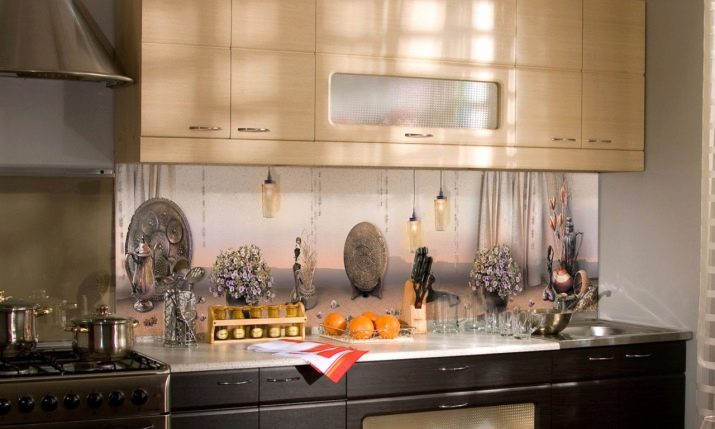
If the hostess likes to often change the interior of the kitchen, you can buy a double-sided apron made of ABS plastic. Its fastening is carried out not on liquid nails, but on specialized wall profiles.
Beautiful examples
In order not to miscalculate with the interior of the kitchen, you should first familiarize yourself with the work of experienced craftsmen. The photographs below illustrate how to create a beautiful apron using wall panels and harmoniously fit it into the kitchen space.
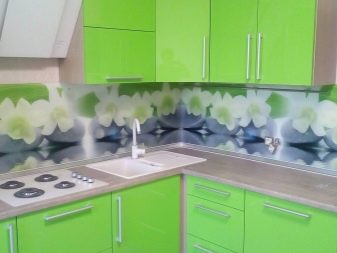
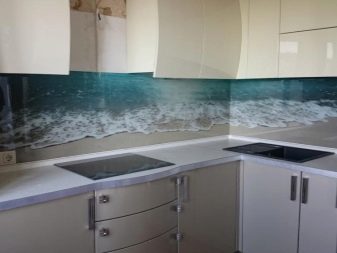
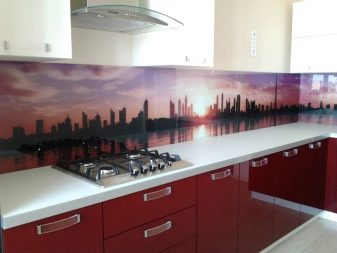
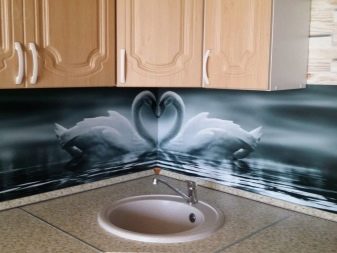
About plastic kitchen aprons in the video below.
